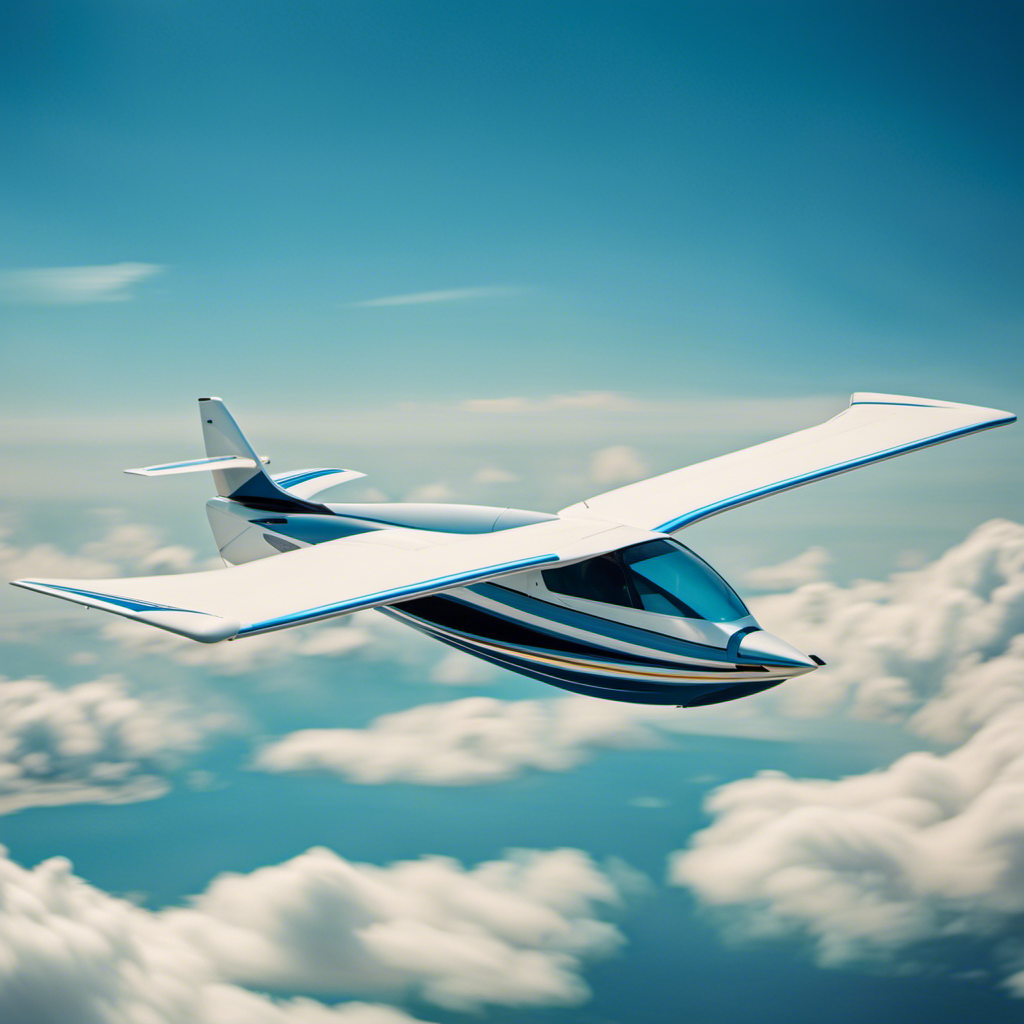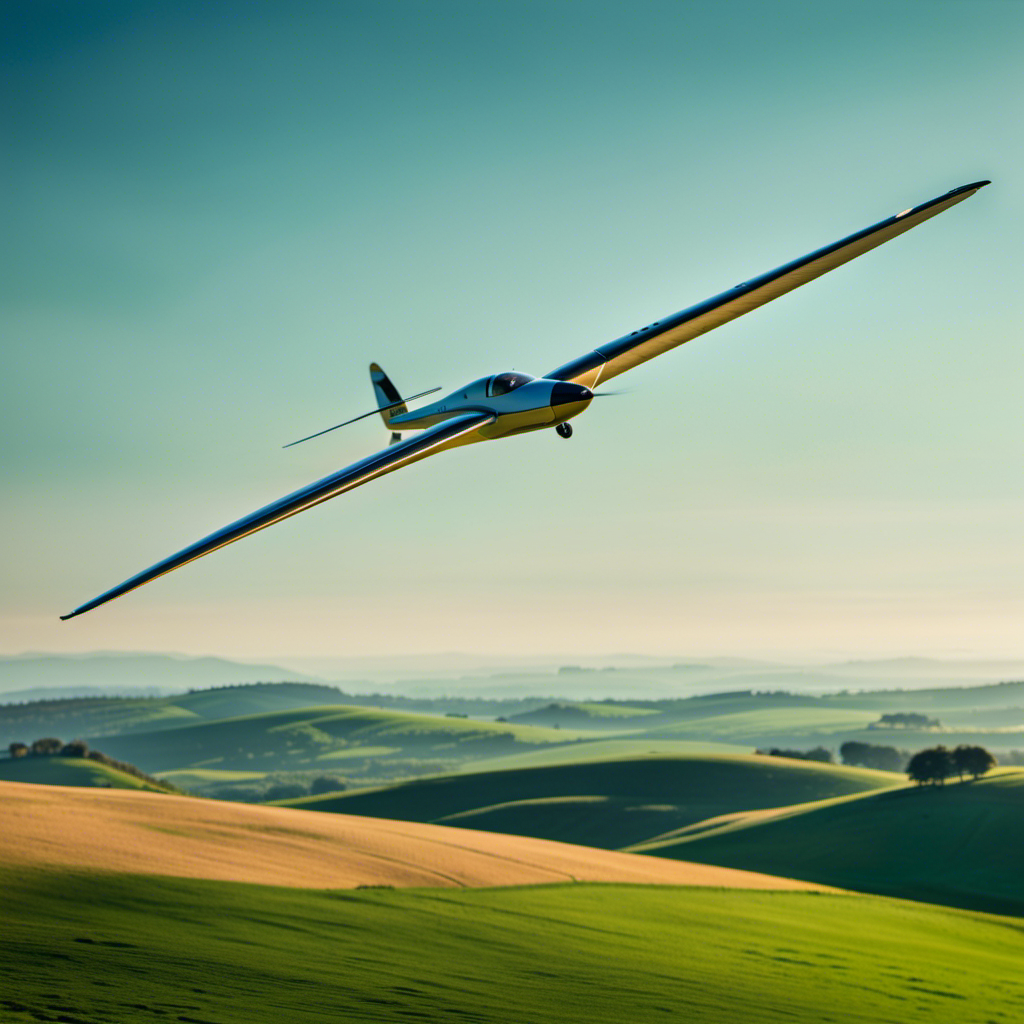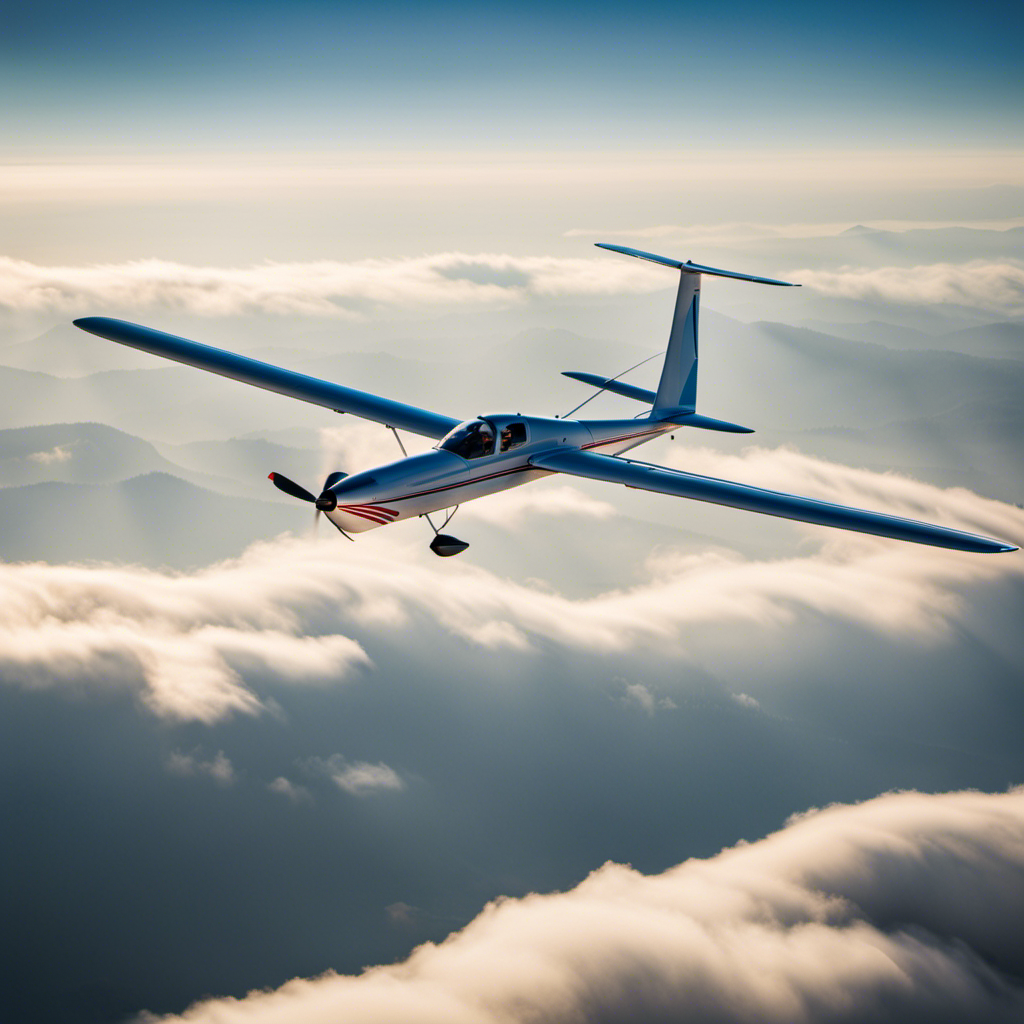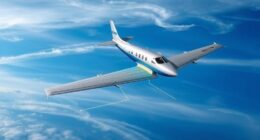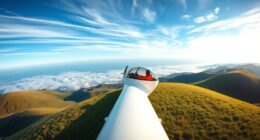As a gliding enthusiast, I understand the importance of finding the perfect two-seater glider that suits your needs and preferences.
In this buyer’s guide, we will explore the key factors to consider when making this important purchase.
From assessing performance and safety features to evaluating comfort and durability, we will leave no stone unturned in our quest for the ultimate gliding experience.
So, let’s dive into the world of 2 seater gliders and uncover the secrets to making an informed decision.
Key Takeaways
- Determining skill level and flying goals is important when selecting a 2 seater glider.
- Safety features, such as emergency parachutes and reinforced cockpits, should be evaluated.
- Comfort and ergonomics, including seating adjustability and storage options, should be considered.
- Cost and value considerations, including initial purchase price and operating costs, should be assessed.
Determine Your Skill Level and Flying Goals
You’ll need to assess your skill level and flying goals before choosing a 2 seater glider. It’s important to consider your flying experience and future aspirations to ensure you select the right aircraft that will meet your needs.
If you’re a beginner pilot with limited experience, you may want to opt for a glider that is forgiving and easy to handle. This will allow you to gain confidence and improve your skills gradually. On the other hand, if you have more advanced flying skills and aspire to participate in competitions or cross-country flights, you’ll need a glider that offers better performance and handling.
When considering your flying goals, think about what you hope to achieve in the future. Do you plan on flying recreationally for leisure and enjoyment? Or do you have ambitions of becoming a competitive glider pilot? Your goals will help determine the type of glider that is best suited for you.
For example, if you’re aiming to compete, you’ll want a glider that has excellent glide ratio, high maneuverability, and good speed range. On the other hand, if you’re flying for leisure, you may prioritize comfort and safety features.
Now that you have assessed your skill level and flying goals, it’s time to consider the glider’s performance and handling.
Consider the Glider’s Performance and Handling
When considering a 2 seater glider, it’s important to evaluate its performance and handling characteristics. These factors play a crucial role in determining the overall flying experience and suitability for your needs. Performance considerations include the glider’s speed, glide ratio, and maneuverability. The handling factors encompass the glider’s responsiveness, stability, and control. To assist you in making an informed decision, I have compiled a table below that outlines the key performance and handling aspects to consider when evaluating a 2 seater glider:
| Performance Considerations | Handling Factors |
|---|---|
| Speed | Responsiveness |
| Glide Ratio | Stability |
| Maneuverability | Control |
Evaluate the Safety Features
Assessing the safety features is crucial when choosing a 2-seater glider that meets your needs. As a knowledgeable buyer, you must carefully evaluate the safety features of the glider before making a decision. Here are three important sub-lists to consider:
-
Structural Integrity:
-
Look for a glider that is built with high-quality materials, such as carbon fiber or aluminum, which provide strength and durability.
-
Check if the glider has a reinforced cockpit area and a sturdy frame to ensure maximum protection in case of a crash or hard landing.
-
Evaluate the glider’s wing structure, making sure it is designed to withstand high loads and turbulence.
-
Safety Systems:
-
Consider if the glider is equipped with an emergency parachute system, which can be a lifesaver in emergency situations.
-
Look for features like a ballistic recovery system or an airbag system that provide additional protection to the occupants.
-
Evaluate the glider’s anti-spin devices and stall warning systems, as they help prevent dangerous situations during flight.
-
Pilot Protection:
-
Check if the glider has a secure harness system that keeps the pilot and passenger in place during flight.
-
Look for comfortable and supportive seats that reduce fatigue and provide proper posture for long flights.
-
Assess the glider’s visibility features, such as large windows and a clear canopy, to ensure good visibility in all directions.
By thoroughly evaluating the safety features of a 2-seater glider, you can make an informed decision that prioritizes the well-being of you and your passenger.
Now, let’s move on to assessing the comfort and ergonomics of the glider.
Assess the Comfort and Ergonomics
When it comes to assessing the comfort and ergonomics of a glider, there are several key points to consider.
Firstly, seating and adjustability play a crucial role in ensuring a comfortable flight. The ability to adjust the seat position and backrest angle can help alleviate fatigue during long flights.
Secondly, cockpit space and storage are important factors to evaluate. Sufficient space to move around and store essential items such as charts, water, and personal belongings can greatly enhance the overall flying experience.
Lastly, noise and vibration levels should not be overlooked. A well-designed glider will have effective soundproofing measures in place to reduce noise and minimize vibrations, resulting in a more pleasant and enjoyable flight.
Seating and Adjustability
The seating in a 2 seater glider is adjustable to ensure a comfortable flying experience. Most gliders offer adjustable seat backs, allowing pilots to find their preferred recline angle. Some gliders also have adjustable leg rests that can be extended or retracted to accommodate pilots of different heights. These features ensure that pilots can find the optimal seating position for their individual comfort needs.
In terms of adjustability options, some gliders even offer adjustable lumbar support, allowing pilots to fine-tune the level of back support they desire. This attention to seating comfort and adjustability demonstrates the commitment of glider manufacturers to providing a comfortable flying experience for pilots.
Moving on to the next section, let’s explore the cockpit space and storage options available in 2 seater gliders.
Cockpit Space and Storage
In terms of cockpit space, there is enough room for two people to comfortably sit side by side in a 2 seater glider. The cockpit is designed with ergonomics in mind, ensuring that pilots have ample space to move and operate controls without feeling cramped. Additionally, storage options are available to keep essential items within reach during flight. Here are three key features to consider:
-
Ample Legroom: The glider is designed with generous legroom, allowing pilots to stretch their legs and maintain a comfortable seating position for long flights.
-
Convenient Storage Compartments: The cockpit is equipped with strategically placed storage compartments to store personal belongings, navigation equipment, and emergency supplies.
-
Easy Access to Controls: The layout of the cockpit ensures easy access to all essential controls, minimizing the need for excessive movement and maximizing pilot efficiency.
Transitioning to the next section, it is important to also consider the noise and vibration levels in a 2 seater glider.
Noise and Vibration Levels
Transitioning to the noise and vibration levels, it’s important to consider how these factors affect the overall flying experience.
In a 2 seater glider, noise reduction and vibration control are crucial for a comfortable and safe flight. When it comes to noise reduction, insulation materials such as foam or rubber can be used to dampen external sounds. Additionally, careful design of the aircraft’s structure can help minimize noise generated by the glider itself.
Vibration control is equally important, as excessive vibrations can cause discomfort and fatigue. The use of vibration-damping materials and well-engineered components can significantly reduce vibrations during flight. By addressing noise and vibration levels, the flying experience becomes more enjoyable and less fatiguing.
Now, let’s examine the durability and maintenance requirements of a 2 seater glider.
Examine the Durability and Maintenance Requirements
Check out how durable and easy to maintain 2 seater gliders are. When considering the durability of a glider, there are several important factors to keep in mind.
First, you’ll want to examine the construction materials used. Look for gliders made from high-quality materials such as aluminum or carbon fiber, as these are known for their strength and longevity. Additionally, consider the design of the glider. Look for features like reinforced joints and sturdy wings to ensure maximum durability.
Maintenance requirements are another crucial aspect to consider. Gliders, like any other aircraft, require regular maintenance to ensure safe operation. This includes routine inspections, lubrication of moving parts, and cleaning of the glider’s exterior. It’s important to understand what specific maintenance tasks are required for the glider you’re considering, as well as the frequency at which they need to be performed.
Transitioning to the next section, researching the manufacturer and their reputation is essential. By doing so, you can gain insight into the quality of their products and their commitment to customer satisfaction. Additionally, you can learn about any known issues or recalls associated with the glider model you’re interested in. So, before making a purchase, take the time to thoroughly research the manufacturer and their reputation in the glider industry.
Research the Manufacturer and Reputation
Researching the manufacturer and their reputation is crucial before making a purchase, as it provides insight into the quality of their products and their commitment to customer satisfaction. Here are four important points to consider when conducting this research:
-
Company History: Start by learning about the manufacturer’s background and how long they have been in the industry. A well-established company with a long history typically indicates reliability and expertise.
-
Product Quality: Look for customer reviews and ratings to gauge the overall quality of the manufacturer’s products. Pay attention to any recurring issues or complaints, as they may indicate potential problems with durability or design.
-
Customer Service: Investigate the manufacturer’s reputation for customer service. Are they responsive to inquiries and concerns? Do they offer warranty or maintenance support? A manufacturer that prioritizes customer satisfaction is more likely to provide ongoing assistance and address any issues that may arise.
-
Industry Reputation: Consider the manufacturer’s standing within the industry. Are they known for innovation and excellence? Have they received any awards or certifications? A reputable manufacturer often demonstrates a commitment to producing high-quality products.
By conducting thorough research on the manufacturer and their reputation, you can make an informed decision and ensure that you are investing in a reliable and reputable product.
Now, let’s move on to considering the cost and value of the 2 seater glider.
Consider the Cost and Value
When considering the cost and value of a 2 seater glider, there are several key points to keep in mind.
The initial purchase price is an important factor, as it sets the foundation for the overall investment.
It’s also crucial to consider the operating costs and fuel efficiency, as these will impact the long-term expenses of owning the glider.
Additionally, the resale value and depreciation should be taken into account, as they can greatly affect the overall value and return on investment.
Initial Purchase Price
To get started, you’ll want to consider the initial purchase price of the 2 seater glider. When looking at the initial purchase price, there are a few important factors to keep in mind:
-
Budget constraints:
-
Determine your budget before starting your search.
-
Take into account not just the purchase price, but also any additional costs such as insurance or maintenance fees.
-
Features and specifications:
-
Research the different models available and compare their prices.
-
Consider the features and specifications that are important to you, such as the glider’s performance capabilities or safety features.
Considering the initial purchase price is crucial, as it sets the foundation for your buying decision. Once you have a clear understanding of the costs involved, you can then move on to the next important aspect of owning a 2 seater glider: operating costs and fuel efficiency.
Operating Costs and Fuel Efficiency
Once you’ve determined the initial purchase price of the 2 seater glider, it’s important to consider the operating costs and fuel efficiency. These factors can greatly impact the overall cost of owning and operating the glider.
When assessing operating costs, it’s crucial to take into account expenses such as maintenance, insurance, and storage fees. Additionally, fuel efficiency plays a significant role in determining the long-term costs of operating the glider. A glider with good fuel efficiency will allow you to fly longer distances while using less fuel, ultimately saving you money.
By carefully evaluating the operating costs and fuel efficiency of a 2 seater glider, you can make an informed decision that aligns with your budget and needs.
Transitioning into the next section, considering the resale value and depreciation of the glider is equally important.
Resale Value and Depreciation
Considering the resale value and depreciation is important when determining the overall cost of owning a 2 seater glider. Here are three key points to keep in mind:
-
Resale Value: Gliders with a strong resale value hold their worth better over time. Factors such as brand reputation, condition, and popularity can affect resale value. Research the market and choose a glider with a good track record.
-
Depreciation: Gliders, like any other vehicle, will depreciate over time. However, some models depreciate at a slower rate than others. Look for gliders that have a slower depreciation rate, as this will help minimize your financial loss in the long run.
-
Maintenance and Upkeep: Proper maintenance and regular care can help maintain your glider’s value. Keep records of any maintenance work and inspections to demonstrate that your glider is well-maintained when it comes time to sell.
Considering these factors will ensure that you make a wise investment in a 2 seater glider.
Now, let’s move on to the next section and discuss the importance of taking a test flight or demo.
Take a Test Flight or Demo
Before making a purchase, it’s important to take a test flight or demo the 2 seater glider. This step is crucial as it allows you to experience firsthand the performance and handling characteristics of the glider. A test flight gives you the opportunity to evaluate how the glider responds to your inputs and how it performs in different flight conditions. By taking a test flight, you can assess if the glider meets your specific needs and preferences.
There are several benefits to taking a test flight. Firstly, it allows you to determine if the glider is comfortable for you and your potential passenger. You can check if the seating position, visibility, and cockpit layout are suitable for your needs. Secondly, a test flight enables you to assess the glider’s handling qualities, such as its responsiveness and stability. You can evaluate how the glider performs during takeoff, landing, and in-flight maneuvers.
To ensure a safe and informative test flight, it is essential to find a reputable instructor who specializes in gliders. They will have the knowledge and experience to guide you through the test flight process and provide valuable insights. A skilled instructor can help you interpret the glider’s behavior and answer any questions you may have.
Consulting with experienced pilots or instructors is the next step in the process of selecting a 2 seater glider. They can provide valuable advice and guidance based on their years of experience in the field. Their insights can help you make an informed decision and choose a glider that best suits your needs and flying style.
Consult with Experienced Pilots or Instructors
After taking a test flight or demo in a 2-seater glider, it is important to gather more information about the aircraft from experienced pilots or instructors. These individuals have a wealth of knowledge and expertise that can help guide your decision-making process.
By consulting with them, you can gain insights into the specific features and capabilities of different glider models that align with your flying goals. Experienced pilots and instructors can provide valuable advice on the performance characteristics of various gliders, such as their speed, maneuverability, and stability. They can also offer insights into the handling qualities of different gliders, including their responsiveness to control inputs and their overall flight behavior.
Additionally, they can share their personal experiences flying different models and provide recommendations based on your skill level and intended use. Engaging in discussions with experienced pilots and instructors allows you to tap into their wealth of knowledge and benefit from their years of flying experience.
Make an Informed Decision and Purchase
To make an informed decision and purchase the right 2 seater glider for you, it’s essential to carefully evaluate the specific features and capabilities that align with your flying goals. There are several factors to consider when choosing a glider, and expert recommendations can play a crucial role in guiding your decision.
One of the key factors to consider is the glider’s performance. This includes its glide ratio, maximum speed, and maneuverability. A glider with a higher glide ratio will allow you to cover more distance with each glide, while a higher maximum speed can provide a thrilling experience. Additionally, maneuverability is important for performing aerobatics or flying in challenging conditions.
Another factor to consider is the glider’s safety features. Look for gliders that have been certified by reputable aviation authorities and have a good safety record. Features such as airbags, parachute systems, and reinforced cockpit structures can greatly enhance the safety of your flights.
Lastly, consider the maintenance requirements and cost of ownership of the glider. Some gliders require more frequent inspections and maintenance, while others have lower operating costs. It’s important to choose a glider that fits within your budget and aligns with your ability to dedicate time towards maintenance.
Frequently Asked Questions
How much does a 2 seater glider typically cost?
The cost of a 2 seater glider can vary depending on several factors. These factors include the type of glider, its age, condition, equipment, and any additional features. On average, a 2 seater glider can cost anywhere between $20,000 to $100,000.
Are there any specific weight restrictions for a 2 seater glider?
When considering a 2 seater glider, it’s important to be aware of weight restrictions and safety regulations. These guidelines ensure optimal performance and minimize risks during flight.
Can a 2 seater glider be converted into a single-seater if needed?
Yes, a 2 seater glider can be converted into a single-seater if needed. The converting capacity allows for easy removal of the second seat. However, it is essential to consider the maintenance requirements for this modification.
What is the average lifespan of a 2 seater glider?
The average lifespan of a 2 seater glider depends on its maintenance requirements. Regular inspections and repairs can extend its life, like a skilled surgeon preserving a beating heart.
Are there any additional accessories or equipment that are recommended for a 2 seater glider?
Additional accessories for a 2 seater glider can enhance safety and comfort. Some recommended equipment includes intercom systems for clear communication with the co-pilot, parachute systems for emergencies, and navigation tools for accurate flight planning. These accessories provide added benefits during flight.
Conclusion
After carefully evaluating all the important factors, it becomes clear that the decision to purchase a 2 seater glider should not be taken lightly.
It is essential to consider your skill level, flying goals, and the glider’s performance, handling, safety features, comfort, and durability.
Assessing maintenance requirements, cost, and value is also crucial.
By taking a test flight, consulting with experienced pilots or instructors, and making an informed decision, you can ensure a euphoric and successful glider experience.
